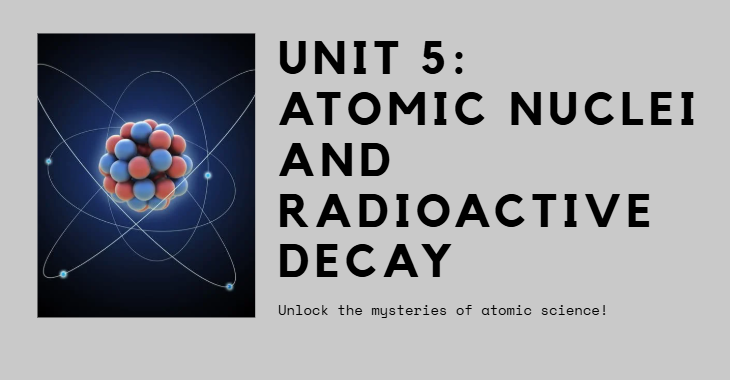PHYSICS S6 UNIT 5: ATOMIC NUCLEI AND RADIOACTIVE DECAY.

About Course
Atomic Nuclei
An atomic nucleus is the tiny, dense core located at the center of every atom. It was discovered by Ernest Rutherford in 1911 through his famous gold foil experiment.
Composition
The nucleus is composed of two types of particles, collectively called nucleons:
- Protons: Positively charged particles. The number of protons (Z) in a nucleus determines the atomic number of an element, which defines the element itself.
- Neutrons: Electrically neutral particles. The number of neutrons (N) can vary for a given element, leading to different isotopes of that element.
The total number of nucleons (protons + neutrons) is called the mass number (A), so A=Z+N. An atomic nucleus is often represented as AZX, where X is the chemical symbol for the element. For example, 126C represents a carbon nucleus with 6 protons and 6 neutrons.
Properties
- Size: Nuclei are incredibly small, ranging from about 1.7 femtometers (fm) for hydrogen (a single proton) to about 11.7 fm for uranium (1 fm = 10−15 meters). Despite their tiny size, they contain almost all of the atom’s mass.
- Charge: Due to the presence of positively charged protons, the nucleus itself carries a positive charge.
- Density: Nuclear matter is incredibly dense, on the order of 2.3×1017 kg/m3. This means that a cubic meter of nuclear matter would have a mass equivalent to a cube of water 61 km on each side!
- Nuclear Force: Protons, being positively charged, would repel each other due to electromagnetic forces. However, a much stronger, short-range attractive force called the strong nuclear force (or nuclear force) binds the nucleons together, overcoming this repulsion and holding the nucleus intact. This force is independent of charge, acting equally between proton-proton, neutron-neutron, and proton-neutron pairs.
- Stability: The stability of a nucleus depends on the balance between the strong nuclear force and the electrostatic repulsion between protons. For lighter nuclei, stable nuclei tend to have an approximately equal number of protons and neutrons (N≈Z). For heavier nuclei, stability generally requires more neutrons than protons (N>Z) to help mitigate the increasing proton-proton repulsion.
Radioactive Decay
Radioactive decay (also known as nuclear decay or radioactivity) is the process by which an unstable atomic nucleus spontaneously loses energy by emitting radiation. This transformation results in the “parent nuclide” changing into a “daughter nuclide,” which can be a different element if the number of protons changes. Materials containing unstable nuclei are considered radioactive.
Radioactive decay is a random process at the level of individual atoms; it’s impossible to predict when a specific atom will decay. However, for a large sample of radioactive material, the decay rate is predictable and characterized by its half-life—the time it takes for half of the radioactive atoms in a sample to decay.
Types of Radioactive Decay
The three most common types of radioactive decay are:
- Alpha Decay (α-decay):
- An unstable nucleus emits an alpha particle, which is identical to a helium-4 nucleus (42He). An alpha particle consists of two protons and two neutrons.
- In alpha decay, the mass number (A) of the parent nucleus decreases by 4, and the atomic number (Z) decreases by 2.
- Example: 23892U → 23490Th +42 He
- Alpha particles are relatively heavy and carry a positive charge, so they have low penetrating power and can be stopped by a sheet of paper. However, they are very damaging if ingested or inhaled.
- Beta Decay (β-decay):
- Beta decay occurs due to the weak nuclear force. There are two main types:
- Beta-minus Decay (β− decay): A neutron in the nucleus transforms into a proton, emitting an electron (e− or β−) and an antineutrino (ṽe).
- The mass number (A) remains the same, but the atomic number (Z) increases by 1.
- Example: 13153I → 13154Xe + e− + ṽe
- Beta-plus Decay (β+ decay) (Positron Emission): A proton in the nucleus transforms into a neutron, emitting a positron (e+ or β+) and a neutrino (ve). A positron is the antiparticle of an electron.
- The mass number (A) remains the same, but the atomic number (Z) decreases by 1.
- Example: 2211Na → 2210Ne + e+ + ve
- Beta-minus Decay (β− decay): A neutron in the nucleus transforms into a proton, emitting an electron (e− or β−) and an antineutrino (ṽe).
- Beta particles (electrons or positrons) are much lighter than alpha particles and have moderate penetrating power, able to be stopped by a few millimeters of aluminum.
- Beta decay occurs due to the weak nuclear force. There are two main types:
- Gamma Decay (γ-decay):
- Gamma decay often occurs after alpha or beta decay when the daughter nucleus is left in an excited energy state. The excited nucleus transitions to a lower energy state by emitting a gamma ray (γ), which is a high-energy photon (a form of electromagnetic radiation).
- Gamma decay does not change the mass number or atomic number of the nucleus; it only releases excess energy.
- Example: After 6027Co undergoes beta-minus decay to form excited 6028Ni∗, the nickel nucleus then releases gamma rays to reach its ground state:
6028Ni∗ → 6028Ni + γ
-
- Gamma rays are highly penetrating and require thick lead or concrete shielding to be significantly attenuated.
Other, Less Common, Decay Modes:
- Electron Capture: An atomic electron is captured by a proton in the nucleus, converting the proton into a neutron and emitting a neutrino. The atomic number decreases by 1, and the mass number remains the same.
- Spontaneous Fission: Very heavy nuclei can spontaneously split into two or more smaller nuclei, often with the emission of neutrons.
Applications of Radioactive Decay
Radioactive decay has numerous practical applications in various fields:
- Medicine:
- Diagnostic Imaging: Radioactive tracers (radioisotopes with short half-lives) are introduced into the body to track physiological processes and image organs (e.g., Technetium-99m for bone scans, Iodine-131 for thyroid imaging).
- Radiotherapy: High-energy radiation (often gamma rays from Cobalt-60 or Cesium-137) is used to destroy cancerous cells, minimizing damage to surrounding healthy tissue.
- Sterilization: Gamma radiation is used to sterilize medical equipment and supplies, as it can penetrate packaging without leaving harmful residues.
- Dating:
- Carbon Dating: Uses the decay of Carbon-14 (half-life of 5,730 years) to determine the age of organic materials (up to ~60,000 years old), commonly used in archaeology and paleontology.
- Uranium-Lead Dating: Utilizes the long decay chains of uranium isotopes (e.g., Uranium-238 to Lead-206) to date very old rocks and geological formations, providing insights into Earth’s history.
- Industry:
- Thickness Gauges: Beta and gamma radiation are used to measure and control the thickness of materials like paper, plastic, and metal foils during manufacturing.
- Smoke Detectors: Americium-241 (an alpha emitter) is used in ionization-type smoke detectors.
- Industrial Tracers: Radioactive isotopes can be used to detect leaks in pipes, monitor fluid flow, and study wear in engines.
- Power Generation:
- Nuclear Power Plants: Utilize controlled nuclear fission (the splitting of heavy atomic nuclei, often Uranium-235) to generate heat, which is then used to produce electricity.
Course Content
ATOMIC NUCLEI-NUCLIDE.
-
Standard Representation of the Atomic Nucleus.
16:28 -
Classification.
12:23 -
Units and Dimensions in Nuclear Physics.
16:25 -
Working Principle a Mass Spectrometer.
18:59 -
Checking my Progress.
35:46
MASS DEFECT AND BIDING ENERGY.
RADIOACTIVITY AND NUCLEAR STABILITY.
APPLICATION OF RADIOACTIVITY.
HAZARDS AND SAFETY PRECAUTIONS OF WHEN HANDLING RADIATIONS.
END UNIT ASSESSMENT
Exercises and Answers
Final Unit Exam.
Student Ratings & Reviews

